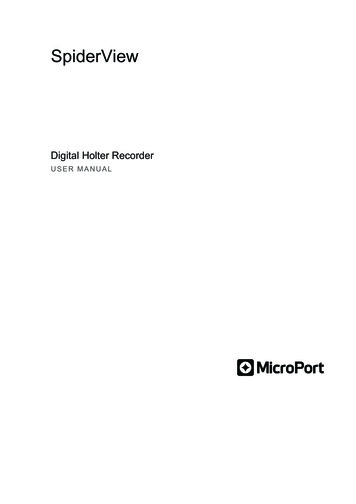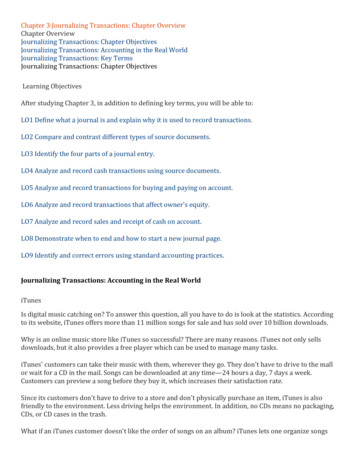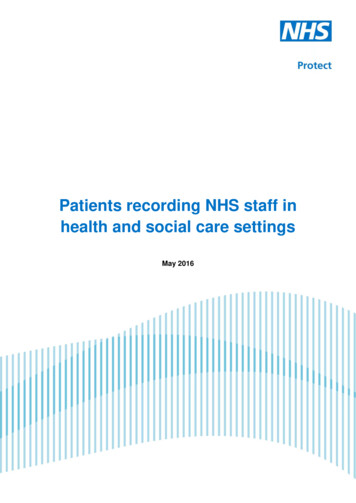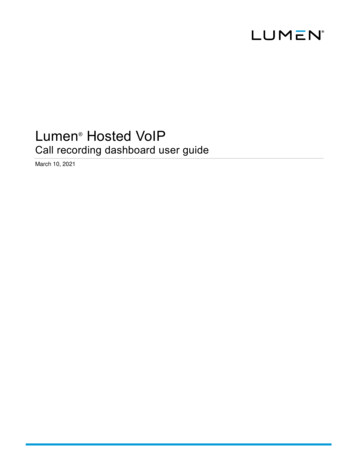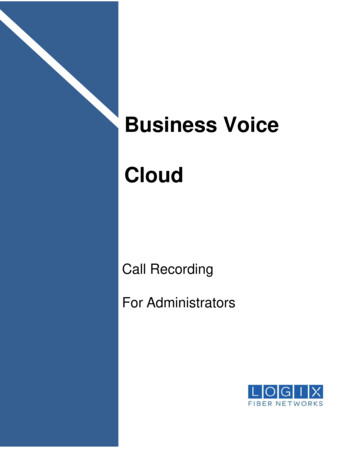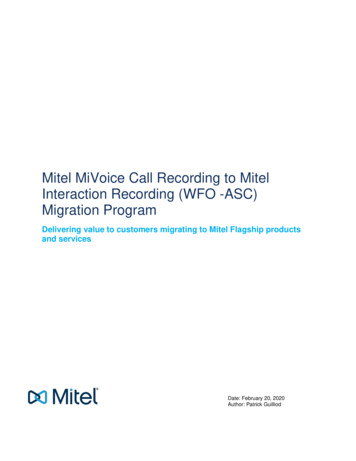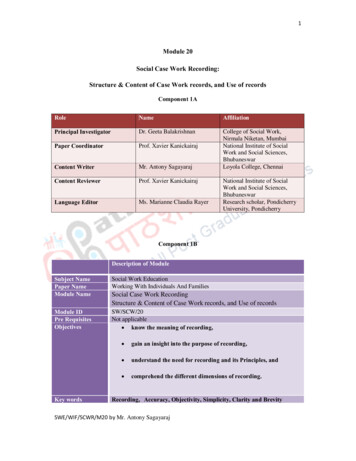
Transcription
C H A P T E R2Recording BusinessTransactionsCHAPTER OBJECTIVESAfter studying this chapter, you should be able to1 Define and use key accounting terms: account,ledger, debit, and credit2 Apply the rules of debit and credit3 Record transactions in the journal4 Post from the journal to the ledger5 Prepare and use a trial balance6 Set up a chart of accounts for a business7 Analyze transactions without a journalChapter Two Recording Business Transactions51
ecause we are diversified acrossnumerous locations in North America, weneeded to put the right information systems in place.We’ve done that. We can nowreview on a moment’s noticethe status of any one of thedozens of real estate projectswe are developing across thecontinent. Similar systems arenow in place in our ski operations and this year we will havedaily financial operating results for each resort available inVancouver by 10 o’clock the following morning. This information intelligence has made our path of growth both clearand predictable.” (Joe S. Houssian, Chairman, Presidentand Chief Executive Officer of Intrawest Corporation.)The 2000 Intrawest Annual Report describesIntrawest, headquartered in Vancouver, British Columbia, as“the leading developer and operator of mountain resortsacross North America.” The company owns year-roundresorts at Whistler/Blackcomb and Panorama in British“BColumbia, Tremblant and MontSte. Marie in Quebec, BlueMountain in Ontario, Copper inColorado, Stratten in Vermont,Snowshoe in West Virginia,Mammoth in California, andMountain Creek in NewJersey. The company also hasan investment in Compagniedes Alpes, France, the largestski company in the world, anda golf resort, Sandestin, inFlorida.Like all other companies,Intrawest represents itself to outsiders through itsfinancial statements. But the accounting information isalso used internally. Intrawest managers at all levels usefinancial statement data for decision making. They keeptrack of the revenue and expenses at the company’s manyresort properties by using accounting records like thosewe illustrate in this chapter. Accounting helps to measureprofits and losses for each resort and for the companyas a whole.2ChapterCH1APTER1Intrawest Corporationwww.intrawest.comVancouver s Bay ellers/default.htmOBJECTIVE 1Define and use key accountingterms: account, ledger, debit,and credit52introduced transaction analysis and the financial statements. But that chapter did not show how the financial statements are prepared.Chapters 2, 3, and 4 cover the accounting process that results in the financial statements.Chapter 2 discusses the processing of accounting information as it is actuallydone in practice. Throughout this chapter and the next two, we continue to illustrateaccounting procedure with service businesses, such as Air & Sea Travel, a systemsdesign engineering company, or a sports franchise like the Vancouver Grizzlies. InChapter 5 we move into merchandising businesses such as The Bay and Zellers.All these businesses use the basic accounting system that we illustrate in this book.By learning how accounting information is processed, you will understand wherethe facts and figures reported in the financial statements come from. This knowledgewill increase your confidence as you make decisions. It will also speed your progressin your business career.The AccountThe basic summary device of accounting is the account, the detailed record of thechanges that have occurred in a particular asset, liability, or item of owner’s equityduring a period of time. For convenient access to the information, accounts aregrouped together in a record called the ledger. In the phrases “keeping the books’’and “auditing the books,’’ books refers to the ledger. Today the ledger usually takesthe form of a computer listing.Accounts are grouped in three broad categories, according to the accountingequation:ASSETS LIABILITIES OWNER’S EQUITYPart One The Basic Structure of Accounting
Recall that in Chapter 1, page 11, we learned that the accounting equation is themost basic tool of the accountant. It measures the assets of the business and theclaims to those assets.AssetsAssets are the economic resources that benefit the business and will continue to doso in the future. Most firms use the following asset accounts.Cash The Cash account shows the cash effects of a business’s transactions. Cashmeans money and any medium of exchange that a bank accepts at face value, suchas bank account balances, paper currency, coins, certificates of deposit, and cheques.Successful companies such as Intrawest usually have plenty of cash. Most businessfailures result from a shortage of cash.Accounts Receivable A business may sell its goods or services in exchange for anoral or implied promise of future cash receipts. Such sales are made on credit (“onaccount”). The Accounts Receivable account contains these amounts. Most sales inCanada and in other developed countries are made on account.KEY POINTA receivable is always an asset. Apayable is always a liability.Notes Receivable A business may sell its goods or services in exchange for apromissory note, which is a written pledge that the customer will pay the business afixed amount of money by a certain date. The Notes Receivable account is a recordof the promissory notes that the business expects to collect in cash. A note receivableoffers more security for collection than a mere account receivable does.Prepaid Expenses A business often pays certain expenses in advance. A prepaid expense is an asset because it provides future benefits to the business. The businessavoids having to pay cash in the future for the specified expense. The ledger holdsa separate asset account for each prepaid expense. Prepaid Rent, Prepaid Insurance,and Office Supplies are accounted for as prepaid expenses.Land The Land account is a record of the cost of land a business owns and uses inits operations. Land held for sale is accounted for separately—in an investment account.Building The cost of a business’s buildings—office, warehouse, garage, and thelike—appear in the Building account. Intrawest owns buildings at Whistler,Tremblant, and its other resorts. Buildings held for sale are separate assets accountedfor as investments. Intrawest builds condominiums at its resorts and sells them.These condominiums would, therefore, not be included in the Building account;they would be a part of inventory, discussed in Chapter 5.Equipment, Furniture, and Fixtures A business has a separate asset account for eachtype of equipment—Computer Equipment, Office Equipment, and Store Equipment,for example. The Furniture and Fixtures account shows the cost of these assets.We will discuss other asset categories and accounts as needed. For example, manybusinesses have an Investments account for their investments in the stocks andbonds of other companies.LiabilitiesRecall that a liability is a debt. A business generally has fewer liability accounts thanasset accounts because a business’s liabilities can be summarized under relativelyfew categories.Accounts Payable This account is the opposite of the Accounts Receivable account.The oral or implied promise to pay off debts arising from credit purchases appears inthe Accounts Payable account. Such purchases are said to be made on account. All companies, including Intrawest, have accounts payable.Chapter Two Recording Business Transactions53
Notes Payable The Notes Payable account is the opposite of the Notes Receivableaccount. Notes Payable represents the amounts that the business must pay becauseit signed a promissory note to borrow money to purchase goods or services.Accrued Liabilities Liability categories and accounts are added as needed. UtilitiesPayable, Interest Payable, and Salary Payable are liability accounts used by most companies.Owner’s EquityTHINKING IT OVERName two things that (1) increaseowner’s equity;(2) decrease owner’s equity.A: (1) Investments by owner andnet income (revenue greater thanexpenses).(2) Withdrawals and net loss(expenses greater than revenue).THINKING IT OVERSuppose you bought a PontiacGrand Am for 24,000 and had toborrow 18,000 to pay for the car.Write your personal accountingequation for this transaction.A:Assets Liabilities Owner’s Equity 24,000 18,000 6,000The owner’s claims to the assets of a business are called owner’s equity. In a proprietorship, like that of Briana Weill or Gary Lyon, described in Chapter 1, or a partnership, owner’s equity is often split into separate accounts for the owner’s capitalbalance and for the owner’s withdrawals. In a partnership, each partner wouldhave a capital balance and a withdrawal account.Capital The Capital account shows the owner's claim to the assets of the business, whether it is Briana Weill or Gary Lyon of Air & Sea Travel. After total liabilities are subtracted from total assets, the remainder is the owner's capital. Amountsreceived from the owner's investment in the business are recorded directly in theCapital account. The Capital balance equals the owner's investments in the business plus net income minus net losses and owner withdrawals over the life of thebusiness. (See the statement of owner's equity in Chapter 1.)Withdrawals When Gary Lyon withdraws cash or other assets from Air & SeaTravel for personal use, the business's assets and owner's equity decrease. Theamounts taken out of the business appear in a separate account entitled Gary Lyon,Withdrawals, or Gary Lyon, Drawings. If withdrawals were recorded directly inthe Capital account, the amount of owner withdrawals would not be highlighted anddecision making would be more difficult. The Withdrawals account shows a decrease in owner's equity.Revenues The increase in owner's equity created by delivering goods or servicesto customers or clients is called revenue. Revenue increases shareholders’ equity.The ledger contains as many revenue accounts as needed. Air & Sea Travel wouldhave a Service Revenue account for amounts earned by providing services forclients. If a business loans money to an outsider, it will need an Interest Revenue account for the interest earned on the loan. If the business rents a building to a tenant,it will need a Rent Revenue account.Expenses Expenses use up assets or create liabilities in the course of operating abusiness. Expenses have the opposite effect of revenues; they decrease owner’s equity. A business needs a separate account for each type of expense, such as SalaryExpense, Rent Expense, Advertising Expense, and Utilities Expense. Businessesstrive to minimize their expenses in order to maximize net income whether theyare Briana Weill, Air & Sea Travel, or Intrawest.Exhibit 2-1 shows how asset, liability, and owner’s equity accounts can be groupedinto the ledger.Double-Entry AccountingAccounting is based on a double-entry system, which means that we record the dualeffects of a business transaction. Each transaction affects at least two accounts. Forexample, in Chapter 1, Gary Lyon’s 50,000 cash investment in his travel agencyincreased both the Cash account and the Capital account of the business. It wouldbe incomplete to record only the increase in the entity’s cash without recording theincrease in its owner’s equity.Consider a cash purchase of supplies. What are the dual effects of this transaction?54Part One The Basic Structure of Accounting
Exhibit 2-1CashThe Ledger (Asset, Liability,and Owner’s EquityAccounts)Many individualasset accountsLedgerAccountsPayableMany individualliability accountsGary Lyon,CapitalAll individual accounts combinedmake up the company's ledger.Many individualowner's equityaccountsThe purchase (1) decreases cash and (2) increases supplies. A purchase of supplieson credit (1) increases supplies and (2) increases accounts payable. A cash paymenton account (1) decreases cash and (2) decreases accounts payable. All transactionshave at least two effects on the accounts of the entity.The T-AccountHow do we record transactions? The account format used for most illustrations inthis book is called the T-account because it takes the form of the capital letter “T.” Thevertical line in the letter divides the account into its left and right sides. The account title rests on the horizontal line. For example, the Cash account of a businessappears in the following T-account format:KEY POINTA T-account is a quick way to showthe effect of transactions on aparticular account—a usefulshortcut in accounting.Cash(Left side)DebitKEY POINT(Right side)CreditThe left side of the account is called the debit side, and the right side is called thecredit side. The words debit and credit can be confusing because they are new. Tobecome comfortable using them, simply remember this:debitcredit left sideright sideThe accounting equation mustbalance after every transaction.But verifying that total assets total liabilities owner’s equity isno longer necessary after everytransaction. The equation willbalance as long as the debits ineach transaction equal the creditsin the transaction.Even though left side and right side may be more convenient, debit and credit aredeeply entrenched in business.1 Debit and credit are abbreviated as follows: Dr Debit Cr Credit1The words debit and credit have a Latin origin (debitum and creditum). Pacioli, the Italian monk whowrote about accounting in the fifteenth century, used these terms.Chapter Two Recording Business Transactions55
OBJECTIVE 2Apply the rules of debit andcreditIncreases and Decreases in the AccountsThe type of an account determines how increases and decreases in it are recorded.For any given account, all increases are recorded on one side, and all decreases arerecorded on the other side. Increases in assets are recorded in the left (debit) sideof the account. Decreases in assets are recorded in the right (credit) side of the account. Conversely, increases in liabilities and owner’s equity are recorded by credits.Decreases in liabilities and owner’s equity are recorded by debits. These are therules of debit and credit.In everyday conversation, we may praise someoneStudent to Studentby saying, “She deserves credit for her good work.”In your study of accounting forget this general usage.Remember that debit means left side and credit meansI can never remember which accounts are increasedright side. Whether an account is increased or decreasedand decreased by debits and which accounts areby a debit or credit depends on the type of accountincreased and decreased by credits. The easiest way(see Exhibit 2-2).for me to remember is to memorize Exhibit 2-2.In a computerized accounting system, the computerI picture Exhibit 2-2 in my mind when I look at ainterprets debits and credits as increases or decreasesnew transaction.by account type. For example, a computer reads a debitto Cash as an increase to that account and a credit toSandy H., EdmontonAccounts Payable as an increase to that account.This pattern of recording debits and credits is basedon the accounting equation:ASSETS LIABILITIES OWNER’S EQUITYAssets are on the opposite side from liabilities and owner’s equity. Therefore, increases and decreases in assets are recorded in the opposite manner from liabilities and owner’s equity. And liabilities and owner’s equity, which are on the sameside of the equal sign, are treated in the same way. Exhibit 2-2 shows the relationshipbetween the accounting equation and the rules of debit and credit.To illustrate the ideas diagrammed in Exhibit 2-2, reconsider the first transaction from Chapter 1. Gary Lyon invested 50,000 in cash to begin the travel agency.The company received 50,000 cash from Lyon and gave him the owner’s equity. Weare accounting for the business entity, Air & Sea Travel. What accounts of Air &Sea Travel are affected? By what amounts? On what side (debit or credit)? The answer is that Assets and Capital would increase by 50,000, as the following T-accountsshow:ASSETS LIABILITIES CashLEARNINGTIPIn all transactions, total debitsmust equal total credits.OWNER’S EQUITYGary Lyon, ,000Notice that Assets Liabilities Owner’s Equity and that total debit amounts total credit amounts. Exhibit 2-3 on page 58 illustrates the accounting equation andAir & Sea Travel’s first three transactions.EXHIBIT 2-2The Accounting Equation andthe Rules of Debit and Credit(The Effects of Debits andCredits on Assets, Liabilities,and Owner’s Equity)56AccountingEquation:Rule ofDebit andCredit:Part One The Basic Structure of AccountingAssetsDebit Credit– LiabilitiesDebit–Credit Owner'sEquityDebit–Credit
The amount remaining in an account is called its balance. This initial transactiongives Cash a 50,000 debit balance, and Gary Lyon, Capital a 50,000 credit balance.The second transaction is a 40,000 cash purchase of land. This transaction affects two assets: Cash and Land. It decreases (credits) Cash and increases (debits)Land, as shown in the T-accounts:ASSETS LIABILITIESCashBalance 50,000 OWNER’S EQUITYGary Lyon, CapitalBalance 50,000Credit forDecrease,40,000Balance 10,000LandDebit forIncrease,40,000Balance 40,000After this transaction, Cash has a 10,000 debit balance ( 50,000 debit balance reducedby the 40,000 credit amount), Land has a debit balance of 40,000, and Gary Lyon,Capital has a 50,000 credit balance as shown in the middle section of Exhibit 2-3 (labelled Transaction 2).Transaction 3 is a 500 purchase of office supplies on account. This transactionincreases the asset Office Supplies and the liability Accounts Payable, as shown inthe following accounts and in the right side of Exhibit 2-3 (labelled Transaction 3):ASSETSCashBalance 10,000 LIABILITIESAccounts Payable OWNER’S EQUITYGary Lyon, CapitalBalance 50,000Credit forIncrease, 500Balance 500Office SuppliesDebit forIncrease, 500Balance 500LandBalance 40,000We can create accounts as they are needed. The process of creating a new T-account in preparation for recording a transaction is called opening the account. ForTransaction 1, we opened the Cash account and the Gary Lyon, Capital account. ForTransaction 2, we opened the Land account, and for Transaction 3, Office Suppliesand Accounts Payable.We could record all transactions directly in the accounts as we have shown for thefirst three transactions. However, that way of accounting does not leave a clearrecord of each transaction. You may have to search through all the accounts to findboth sides of a particular transaction. To save time, accountants keep a record ofeach transaction in a journal and then transfer this information from the journalinto the accounts.Chapter Two Recording Business Transactions57
EXHIBIT 2-3The Accounting Equation and the First Three Transactions of Air & Sea TravelTransaction 1Received 50,000 cash that the ownerinvested in the business.Transaction 2Paid 40,000 cashto purchase land.Transaction 3Purchased office supplies on account for 500. 500Office Supplies 10,000Cash 10,000Cash 50,000Cash 50,000GaryLyon,Capital 40,000Land 50,000GaryLyon,Capital 500AccountsPayable 40,000Land 50,000GaryLyon,CapitalAssets Liabilities Owner's EquityS TOP & T HINKCan you prepare a balance sheet for Air & Sea Travel after the first transaction onApril 2, 2002? Can you prepare an income statement?Answer:AIR & SEA TRAVELBalance SheetApril 2, 2002AssetsCash .Total assets .Liabilities 50,000 50,000 Owner’s EquityGary Lyon, CapitalTotal liabilities andowner’s equity0 50,000 50,000You could not yet prepare an income statement because the business has experienced no revenues or expenses.OBJECTIVE 3Record transactions in thejournalRecording Transactions in JournalsIn practice, accountants record transactions first in a journal, which is a chronological record of the entity’s transactions. The journalizing process follows foursteps:1. Identify the transactions from source documents, such as bank deposit slips,sales invoices, or cheque stubs.2. Specify each account affected by the transaction and classify it by type (asset,liability, or owner’s equity).3. Determine whether each account is increased or decreased by the transaction.58Part One The Basic Structure of Accounting
Using the rules of debit and credit, determine whether to debit or credit the account to record its increase or decrease.4. Enter the transaction in the journal, including a brief explanation for the journalentry. The debit side of the entry is entered first and the credit side last.Step 4, “Enter the transaction in the journal,’’ means to record the transactionin the journal. This step is also called “making the journal entry’’ or “journalizingthe transaction.’’These four steps are completed in a computerized accounting system as well asin a manual system. In step 4, however, the journal entry is generally entered intothe computer by account number, and the account name is then listed automatically.Most computer programs replace the explanation in the journal entry with someother means of tracing the entry back to its source documents.Let’s apply the four steps to journalize the first transaction of Air & Sea Travel—the business’s receipt of Lyon’s 50,000 cash investment in the business.Step 1. The source documents are Air & Sea Travel’s bank deposit slip and the 50,000 cheque, which is deposited in the business bank account.Step 2. The accounts affected by the transaction are Cash and Gary Lyon, Capital.Cash is an asset account, and Gary Lyon, Capital is an owner’s equity account.Step 3. Both accounts increase by 50,000. Therefore, Cash, the asset account, is increased (debited), and Gary Lyon, Capital, the owner’s equity account,is increased (credited).Step 4. The journal entry isKEY POINTIn a journal entry, such as Exhibit2-4, the account debited is alwayswritten first (not indented). Theaccount credited is indented onthe line below, and theexplanation is not indented on thenext line. Journal entries shouldalways be recorded in this format.LEARNINGDateAccounts and ExplanationDebitApr. 2aCashb .Gary Lyon, Capitalc .Received initial investment from owner.fTIPWhen analyzing a transaction, firstpinpoint the obvious effects on theaccounts. For example, casheffects are easy to identify. Didcash increase or decrease? Thenfind its effect on other accounts.Credit50,000d50,000eThe journal entry includes (a) the date of the transaction, (b) the title of the accountdebited (placed flush left), (c) the title of the account credited (indented slightly), thedollar amounts of (d) the debit (left) and (e) the credit (right)—dollar signs are omitted in the money columns—and (f) a short explanation of the transaction.The journal offers information that the ledger accounts do not provide. Eachjournal entry shows the complete effect of a business transaction. Consider GaryLyon’s initial investment. The Cash account shows a single figure, the 50,000 debit.We know that every transaction has a credit, so in what account will we find the corresponding 50,000 credit? In this illustration, we know that the Capital accountholds this figure. But imagine the difficulties you would face trying to link debits andcredits for hundreds of daily transactions—without a separate record of each transaction. The journal solves this problem and presents the full story for each transaction. Exhibit 2-4 shows how Journal page 1 looks after the first transaction isrecorded.EXHIBIT 2-4JournalDateAccounts and ExplanationApr. 2Cash .Gary Lyon, Capital .Received initial investment from owner.Page 1Ref.DebitThe JournalCredit50,00050,000Chapter Two Recording Business Transactions59
MasterCardwww.mastercard.comOBJECTIVE 4Post from the journal to theledgerRegardless of the accounting system in use, an accountant must analyze everybusiness transaction in the manner we are presenting in these opening chapters. Oncethe transaction has been analyzed, a computerized accounting package performs thesame actions as accountants do in a manual system. For example, when a sales clerkruns your MasterCard through the credit card reader, the underlying accounting system records the store’s sales revenue and receivable from MasterCard. The computerautomatically records the transaction as a journal entry, but an accountant had to program the computer to do so. A computer’s ability to perform routine tasks and mathematical operations quickly and without error frees accountants for decision making.Transferring Information (Posting) from the Journalto the LedgerPosting means transferring the amounts from the journal to the accounts in theledger. Debits in the journal are posted as debits in the ledger, and credits in thejournal as credits in the ledger. The initial investment transaction of Air & Sea Travelis posted to the ledger as shown in Exhibit 2-5. Computers perform this tedioustask quickly and without error. In these introductory discussions we temporarily ignore the date of each transaction in order to focus on the accounts and their dollaramounts.The Flow of Accounting DataExhibit 2-6 summarizes the flow of accounting data from the business transaction allthe way through the accounting system to the ledger. In the pages that follow, we continue the example of Air & Sea Travel and account for six of the business’s earlytransactions. Keep in mind that we are accounting for the business entity, Air & SeaTravel. We are not accounting for Gary Lyon’s personal transactions.Transaction Analysis, Journalizing, and Posting tothe Accounts1.Transaction:Gary Lyons invested 50,000 cash to begin his travel business,Air & Sea Travel.Analysis:Lyon’s investment in Air & Sea Travel increased its asset cash; torecord this increase, debit Cash. The investment also increasedits owner’s equity; to record this increase, credit Gary Lyon,Capital.JournalEntry:Cash . 50,000Gary Lyon, Capital.Received initial investment from owner.AccountingEquation:ASSETSCash 50,000 LIABILITIES 0 50,000OWNER’S EQUITYGary Lyon, Capital50,000The journal entry records the same information that you learnedby using the accounting equation in Chapter 1. Both accounts—Cash and Gary Lyon, Capital—increased because the businessreceived 50,000 cash and gave Lyon 50,000 of capital (owner’sequity) in the business.60Part One The Basic Structure of Accounting
EXHIBIT 2-5Panel A — Journal EntryDateApril 2Accounts and ExplanationDebitCash .Gary Lyon, Capital .Received initial investment from owner.50,000Journal Entry and Posting tothe LedgerCredit50,000Panel B — Posting to LedgerCash50,000WORKING IT OUTPrepare the journal entry to recorda 1,600 payment on account.(1) Identify the accounts.(2) Are these accounts increasedor decreased? Should they bedebited or credited?(3) Make the journal entry, with anexplanation.A: (1) The company paid 1,600 onaccount. The accounts affected areCash and Accounts Payable.(2) Cash (an asset) decreases by 1,600. Accounts Payable (aliability) decreases by the sameamount. To record a decrease in anasset, we use a credit. To record adecrease in a liability, we use adebit. Review Exhibit 2-2.(3) AccountsPayable. 1,600Cash .1,600Made payment onaccount.Gary Lyon, ary Lyon, Capital50,000(1)50,000Air & Sea Travel paid 40,000 cash for land as a future officelocation.Analysis:The purchase decreased cash; therefore, credit Cash. The purchase increased the entity’s asset land; to record this increase,debit actionAnalysisTakes PlaceExhibit 2-6Flow of Accounting DataTransactionEntered inJournalAmountsPosted toLedgerPageFile Edit View Arrange Type WindowListChequesGARY LYONApril 219April 2 2002Pay to theorder ofGary Lyon, CPAXXXXXX, XXXXXXXX, XXXXXXXFor Deposit Only 50,000Type of Owner’s Equity TransactionTotalTHE00GENERICBANK OF CANADAFifty Thousand and/100AssetsLiabilities Owner’s Equity Gary Lyon, CapitalCash 50,000 50,000DOLLARSOwner investment1234567891011121314151617ABDate Accounts and ExplanationsApril 2 CashGary Lyon, CapitalReceived initial investment fromowner.CDebit 50,000DCredit 50,000Date20XXApr. 2Accounts and ExplanationsCashGary Lyon, CapitalInitial investment by owner3Office suppliesCashPurchased office 50,000500Cash50,000Chapter Two Recording Business Transactions61
S TOP & T HINKSuppose you are a lender and Gary Lyon asks you to make a 10,000 business loan toAir & Sea Travel. After the initial investment of 50,000, how would you evaluate Air& Sea Travel as a credit risk? Would your evaluation differ if Lyon had invested only 5,000 of his money and Air & Sea Travel owed 25,000 to another bank?Answer: You would probably view the loan request favourably. Gary Lyon hasinvested 50,000 of his own money in the business. The travel agency has no debts, soit should be able to repay you. However, if the owner had invested only 5,000 in thebusiness and it had liabilities of 25,000, Air & Sea Travel would be a less attractivecredit risk.JournalEntry:AccountingEquation:Land . 40,000Cash .Paid cash for land.ASSETSCashLand– 40,000 40,00040,000 LIABILITIES OWNER’SEQUITY 0 0This transaction increased one asset, land, and decreased anotherasset, cash. The net effect on the business’s total assets was zero,and there was no effect on liabilities or owner’s equity. We usethe term net in business to mean an amount a
Accounts Payable This account is the opposite of the Accounts Receivable account. The oral or implied promise to pay off debts arising from credit purchases appears in the Accounts Payable account. Such purchases are said to be made on account. All com-panies, including Intrawest, have accounts payable. Chapter Two Recording Business .



